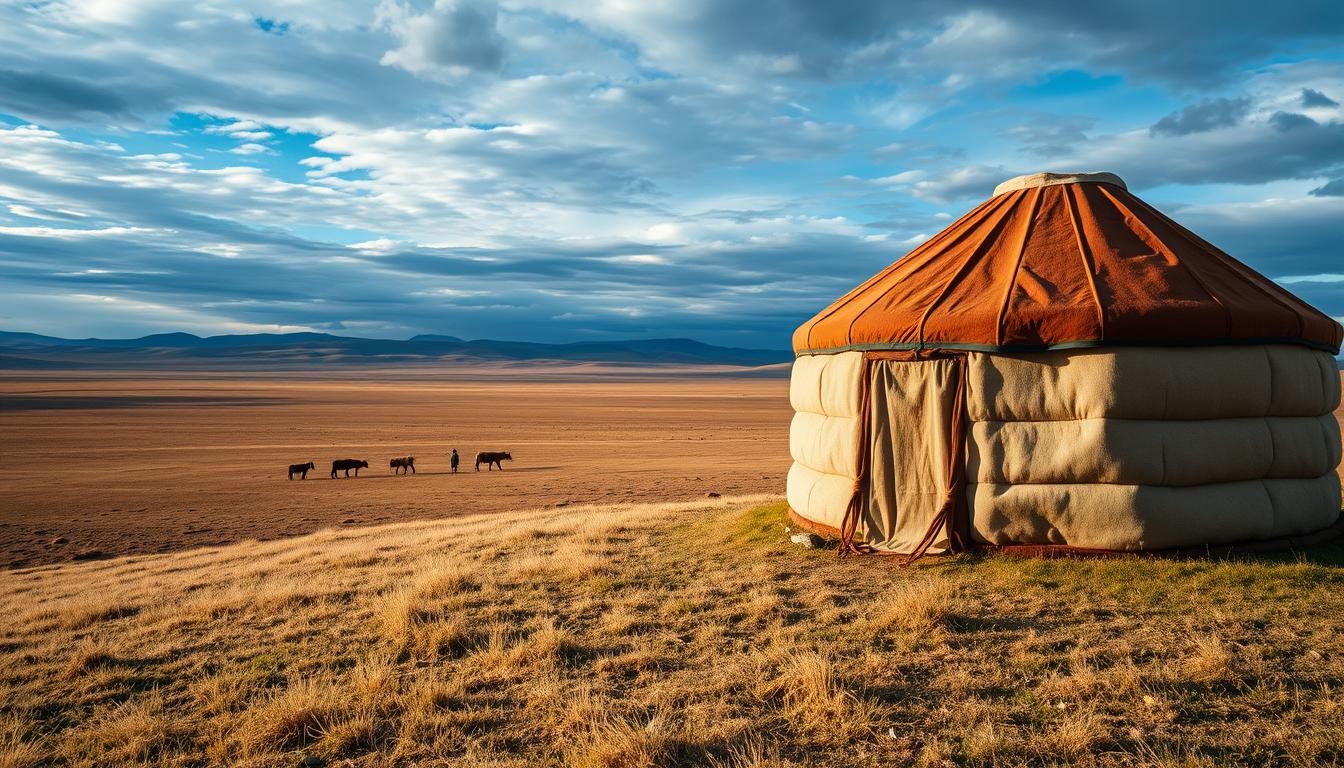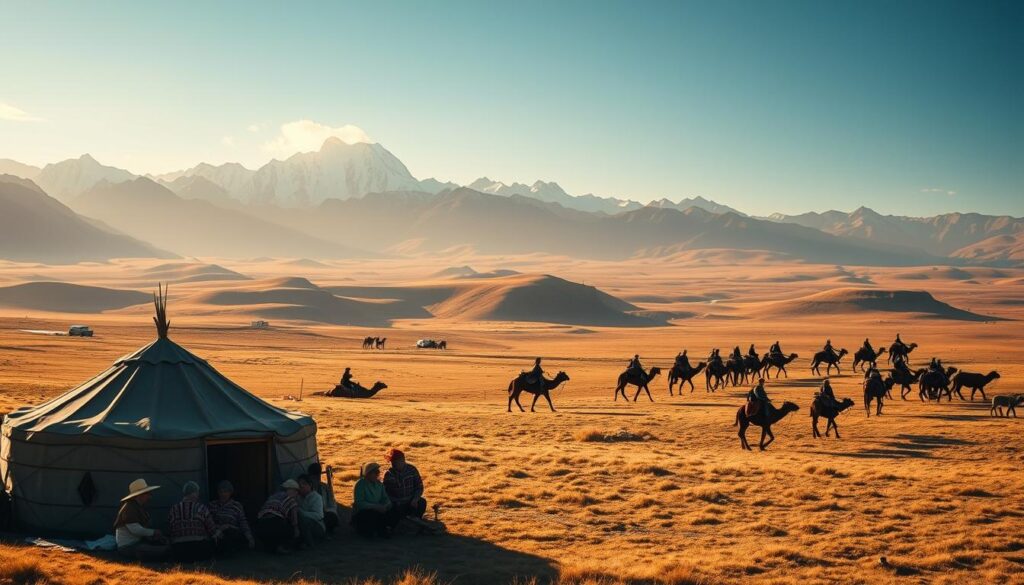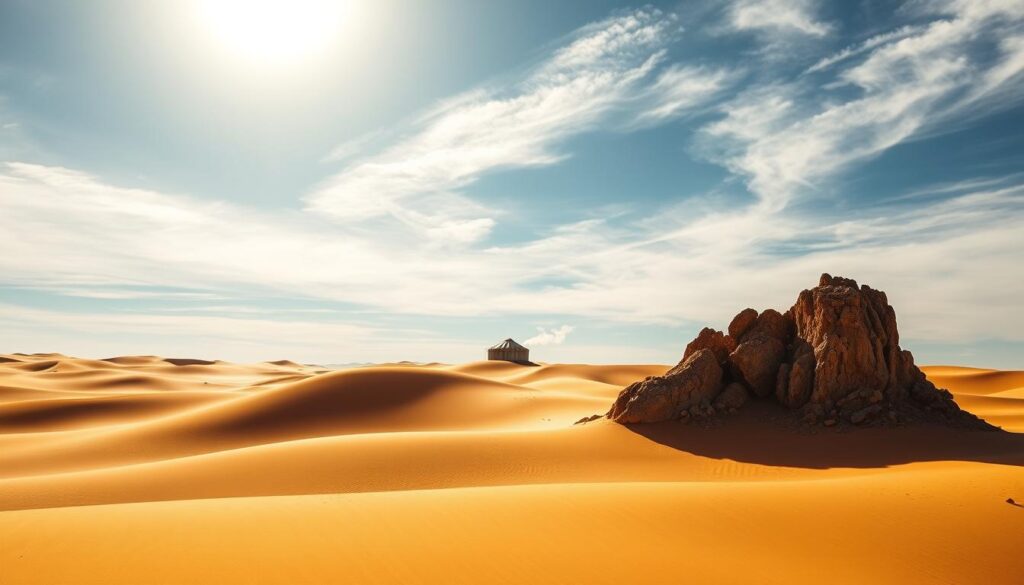Blog
Mongolia: The Ultimate Digital Detox and Nomadic Experience

Imagine escaping the digital grind and immersing yourself in the vast, untouched wilderness of Mongolia. This land of nomadic traditions offers a unique opportunity for a digital detox, allowing you to reconnect with nature and yourself.
In Mongolia, you can experience the thrill of camel riding, the serenity of traditional archery sessions, and the warmth of local cultural experiences. Join a Mongolia Explorer trip and discover the country’s hidden gems, from the legendary wild horses of Khustain Nuruu National Park to the vibrant cultural heritage of Ulaanbaatar.
As you journey through Mongolia in 2026, you’ll be surrounded by breathtaking landscapes and engaging activities that will leave you refreshed and revitalized. Whether you’re looking for a relaxing getaway or an adventure-filled escapade, Mongolia has something to offer.
Key Takeaways
- Experience a digital detox in Mongolia’s untouched wilderness
- Join a guided Mongolia Explorer trip for a unique nomadic experience
- Enjoy camel riding, cultural experiences, and traditional archery sessions
- Explore Khustain Nuruu National Park and witness legendary wild horses
- Immerse yourself in local culture and heritage in Ulaanbaatar
The Allure of Mongolia’s Untouched Wilderness
Mongolia’s vast and untouched wilderness is a siren call to those seeking a digital detox and an authentic travel experience. This land of vast steppes, rugged mountains, and pristine lakes offers an unparalleled opportunity to disconnect from the digital world and reconnect with nature.
The Last Frontier for Authentic Travel 2026 Experiences
Mongolia stands out as the last frontier for authentic travel experiences in 2026. Its untouched landscapes and traditional nomadic culture provide a unique chance for travelers to immerse themselves in an unspoiled environment.
Why Mongolia Is Ideal for Disconnecting from Technology
Mongolia’s remote location and lack of modern infrastructure make it an ideal destination for those looking to disconnect from technology. The country’s vast open spaces and serene landscapes further enhance this disconnection, allowing travelers to focus on the natural world around them.
Physical Disconnection: Limited Infrastructure
The limited infrastructure in Mongolia means that travelers must rely on traditional modes of transportation and communication, effectively disconnecting them from the digital world.
Mental Disconnection: Vast Open Spaces
The vast open spaces of Mongolia’s wilderness have a profound effect on the mind, allowing travelers to clear their thoughts and focus on the present moment.
As one traveler noted,
“The moment I stepped into the Mongolian steppe, I felt a sense of freedom I had never experienced before. The endless skies and rolling hills were a balm to my soul.”
The following table highlights key aspects of Mongolia’s wilderness that contribute to its allure:
| Feature | Description | Benefit |
|---|---|---|
| Vast Open Spaces | Endless steppes and rolling hills | Mental disconnection and peace |
| Limited Infrastructure | Lack of modern amenities | Physical disconnection from technology |
| Nomadic Culture | Traditional lifestyle and hospitality | Authentic cultural experience |
Planning Your Mongolian Adventure for Travel 2026
As you prepare for your Mongolian adventure in 2026, careful planning is essential. Mongolia offers a unique blend of untouched wilderness and nomadic culture, making it an ideal destination for travelers seeking a digital detox experience.
Best Time to Visit: Seasonal Considerations
The best time to visit Mongolia depends on your preferences and what you want to experience. The country has a continental climate with significant seasonal variations.
Summer Travel (June-August): Peak Season Benefits
Summer is the peak tourist season in Mongolia, offering warm weather and long days. It’s ideal for outdoor activities like trekking, horseback riding, and attending the Naadam Festival. As one travel expert notes, “Summer in Mongolia is a time of vibrant festivals and endless sunshine.”
Shoulder Seasons: Spring and Fall Advantages
Spring (April-May) and fall (September-October) are considered shoulder seasons. These periods offer mild temperatures and fewer tourists, making them excellent times for a more serene experience. Spring brings blooming wildflowers, while fall showcases the changing foliage.
Essential Documents and Visa Requirements
Before traveling to Mongolia, ensure you have the necessary documents. Most travelers require a visa, which can be obtained upon arrival or in advance from a Mongolian embassy or consulate. Check the specific requirements for your nationality.
How to Create Your Personal Digital Detox Plan
Creating a digital detox plan involves setting clear goals for your disconnection. Consider what digital devices you can leave behind and how you will stay engaged without them.
“The key to a successful digital detox is planning and a willingness to disconnect.”
Prepare analog alternatives like journals, maps, and guidebooks to enhance your experience.
How to Navigate Mongolia’s Vast Landscapes
As you embark on your Mongolian digital detox journey, understanding how to navigate the country’s vast landscapes is essential. Mongolia’s expansive steppes and rugged terrain can be challenging to traverse, but with the right transportation options and planning, you can have a safe and enjoyable trip.
Transportation Options Across the Steppe
Mongolia offers various transportation options for travelers, ranging from local drivers and vehicles to public transportation. Hiring a local driver can be an excellent way to navigate the country’s rugged terrain, as they possess knowledge of the land and can handle challenging road conditions.
Hiring Local Drivers and Vehicles
When hiring a local driver, consider their experience and knowledge of the terrain. Ensure that the vehicle is suitable for the terrain and weather conditions you will encounter. A 4×4 vehicle is often necessary for remote areas.
Public Transportation Possibilities
Public transportation in Mongolia is limited, but buses and trucks can be used to travel between major towns. Research your options in advance, as schedules can be unpredictable.
Step-by-Step Guide to Planning Your Route
To plan your route, start by identifying your destinations and the activities you want to do. Research transportation options between locations and consider the time of year and weather conditions. Create a flexible itinerary that allows for adjustments as needed.
Safety Protocols for Remote Travel
When traveling in remote areas, it’s crucial to be prepared for emergencies. Carry a first-aid kit, have a means of communication, and inform someone of your itinerary. Be aware of the weather and potential hazards such as wildlife or steep terrain.
By understanding your transportation options, planning your route carefully, and following safety protocols, you can navigate Mongolia’s vast landscapes with confidence, enjoying the beauty and tranquility of this digital detox destination.
Immersing in Nomadic Culture: A Step-by-Step Guide
To truly understand Mongolian culture, consider immersing yourself in the nomadic lifestyle through homestays and cultural activities. This approach not only enriches your travel experience but also provides a unique insight into the traditional ways of Mongolian nomads.
How to Find and Arrange Authentic Homestays
Finding the right homestay is crucial for a genuine cultural experience. You can achieve this by:
- Working with reputable tour operators who have established connections with nomadic families.
- Making direct connections with nomadic families through local contacts or community-based tourism initiatives.
Working with Reputable Tour Operators
Reputable tour operators can facilitate a smooth and respectful homestay experience. They often have pre-arranged agreements with nomadic families, ensuring that both parties benefit from the arrangement.
Direct Connections with Nomadic Families
For a more personal experience, consider making direct connections with nomadic families. This can be achieved through local community networks or by participating in community-based tourism programs.
Participating in Daily Nomadic Activities
Once you’ve arranged your homestay, you can participate in various daily activities such as:
- Herping animals across the steppes.
- Assisting with traditional dairy product preparation.
- Learning traditional crafts and skills.

Learning Basic Mongolian Phrases for Cultural Connection
Learning a few basic Mongolian phrases can significantly enhance your cultural experience. Simple greetings and expressions of gratitude can go a long way in building rapport with your host family.
Essential phrases include: “Sain baina uu” (hello), “Bayarlalaa” (thank you), and “Tsaanya” (goodbye).
By following these steps, you can immerse yourself in Mongolia’s rich nomadic culture, creating unforgettable memories and fostering meaningful connections with the local community. As you plan your Mongolia travel 2026, consider the enriching experience of nomadic culture travel.
Essential Gear for Your Mongolian Digital Detox
Embarking on a digital detox in Mongolia requires careful preparation, starting with the right gear. As you plan your Travel 2026 adventure to this unique digital detox destination, it’s essential to consider the clothing, equipment, and supplies that will ensure your comfort and safety.
Clothing Essentials for Mongolia’s Extreme Climate
Mongolia’s climate is known for its extremes, with temperatures fluctuating significantly between day and night. Proper clothing is crucial.
Layering Strategies for Temperature Fluctuations
To adapt to the changing temperatures, employ a layering strategy. Start with a breathable base layer, add insulating layers, and finish with a waterproof outer layer.
Footwear for Various Terrains
Mongolia’s diverse landscapes require versatile footwear. From sturdy hiking boots for mountainous terrains to comfortable ger-friendly footwear, your choices will significantly impact your experience.
Analog Alternatives to Digital Devices
In the spirit of a digital detox, consider analog alternatives to your usual digital devices. For instance, a paper map and compass can replace GPS, while a journal can serve as a digital-free diary.
Medical and Emergency Supplies Checklist
Preparing for emergencies is vital. Assemble a kit that includes basic medical supplies, a first-aid guide, and emergency contact information.
By focusing on these essentials, you’ll be well-prepared for your Mongolian digital detox, ensuring a safe and enriching experience in one of the world’s most unique digital detox destinations.
How to Experience Mongolia’s Natural Wonders
From the rugged Gobi Desert to the serene Khuvsgul Lake, Mongolia is a haven for nature lovers and adventure seekers alike. The country’s diverse landscapes offer a wide range of experiences, from trekking in the Altai Mountains to exploring the vast expanses of the Gobi Desert.
The Gobi Desert: Navigation and Highlights
The Gobi Desert is one of Mongolia’s most iconic natural wonders, known for its extreme climate and unique landscapes. Navigating the Gobi requires careful planning and preparation.
Must-See Locations and Phenomena
Visitors to the Gobi Desert should not miss the opportunity to see the Flaming Cliffs, a stunning rock formation known for its vibrant colors. The Gobi is also home to the Bactrian camel, a rare and endangered species.
Desert Safety Precautions
When traveling through the Gobi, it’s essential to take safety precautions seriously. This includes carrying sufficient water, protecting against the extreme sun, and being aware of the risk of sandstorms.

Khuvsgul Lake: Activities and Accommodations
Khuvsgul Lake is another of Mongolia’s natural gems, offering opportunities for boating, fishing, and hiking. Visitors can stay in ger camps around the lake, experiencing the tranquility of the surrounding wilderness.
Altai Mountains: Trekking Routes and Cultural Experiences
The Altai Mountains offer some of the most spectacular trekking routes in Mongolia, with breathtaking scenery and opportunities to experience nomadic culture firsthand. Travelers can stay with local families, learning about traditional ways of life.
For those planning to visit Mongolia in 2026, experiencing these natural wonders will be a highlight of their trip. Whether trekking, camping, or simply taking in the views, Mongolia’s diverse landscapes promise an unforgettable adventure.
Mongolian Cuisine: How to Adapt and Appreciate
As you embark on a digital detox in Mongolia, you’ll discover a rich culinary culture that is deeply rooted in nomadic traditions. Mongolian cuisine is characterized by its simplicity, heartiness, and reliance on locally sourced ingredients.
Step-by-Step Guide to Traditional Nomadic Foods
Traditional Mongolian dishes are often centered around meat and dairy products. A step-by-step guide to preparing these dishes includes:
- Boiling meat to create a nourishing broth
- Using dairy products like airag (fermented horse milk) and aruul (dried curd)
- Preparing boortsog, a type of fried dough pastry
Dietary Considerations and Alternatives for Western Travelers
For Western travelers, adapting to Mongolian cuisine can be challenging due to its high meat content and limited variety of vegetables. However, many nomadic families are accommodating and can offer alternatives.
How to Participate in Food Preparation Rituals
Participating in food preparation is a significant way to engage with nomadic culture. Key aspects include:
Dairy Product Processing
Learning to process dairy products like making aruul or churning airag.
Meat Preparation Techniques
Understanding how to prepare meat according to traditional methods, such as boiling or drying.
Cultural Etiquette: How to Respect Nomadic Traditions
As you embark on your Mongolian adventure, learning about the cultural etiquette of the nomadic people will enrich your journey. Understanding and respecting local customs is crucial for a meaningful and positive experience.
Ger (Yurt) Etiquette: Comprehensive Guide
When staying with nomadic families, you’ll likely be invited into their ger, a traditional Mongolian yurt. Respecting the ger’s cultural significance is essential.
Entering and Moving Within the Ger
Upon entering, follow the host’s guidance, as the ger has specific rules. Typically, you’ll need to enter with your right foot first and avoid stepping on the threshold. Move clockwise within the ger, as this is considered respectful.
Seating and Sleeping Arrangements
Be mindful of seating and sleeping arrangements, as they are determined by social hierarchy and family status. Usually, the most honored guests are seated on the right-hand side of the ger.
Gift-Giving Protocol When Staying with Families
Gift-giving is a significant custom when staying with nomadic families. Consider bringing gifts such as high-quality tea, candies, or small household items. Present gifts with both hands as a sign of respect.
How to Participate in Religious and Spiritual Practices Respectfully
Mongolia has a rich spiritual heritage, with a mix of Buddhist and shamanistic practices. When participating in religious ceremonies, dress modestly and follow the lead of your hosts. Be respectful of sacred sites and artifacts.
By being mindful of these cultural etiquette guidelines, you’ll not only show respect for the nomadic traditions but also enhance your Mongolian travel experience in 2026.
Practical Steps for Overcoming Challenges of Disconnection
Disconnecting from the digital world in Mongolia’s remote areas demands mental and logistical preparation. As you plan your digital detox destinations trip for Travel 2026, it’s essential to understand the challenges you might face and how to overcome them.
Mental Preparation Techniques for Digital Withdrawal
Preparing yourself mentally for a digital detox is crucial. Start by setting clear goals for your trip and understanding what you hope to achieve. Practice mindfulness and meditation to help manage any anxiety related to disconnection.
How to Establish Communication Plans in Remote Areas
While the goal of a digital detox is to disconnect, having a plan for emergency communication is vital. Research local SIM card options and satellite phone services available in Mongolia. Inform your family and friends about your itinerary and how you can be reached in case of an emergency.
Emergency Protocols Without Constant Connectivity
Establishing emergency protocols is a critical step. This includes:
- Carrying a personal locator beacon (PLB) or satellite messenger.
- Knowing basic emergency phrases in Mongolian.
- Having a detailed itinerary with your accommodation and transportation details.
Pre-Trip Safety Arrangements
Before you leave, ensure you have made all necessary safety arrangements. This includes registering with your country’s travel advisory department, purchasing travel insurance that covers emergency evacuations, and leaving a copy of your itinerary with a trusted friend or family member.
On-the-Ground Emergency Resources
Identify local emergency resources such as hospitals, police stations, and your country’s embassy or consulate in Mongolia. Keep important contact numbers handy, either memorized or written down, as you may not have constant access to your phone.
Conclusion: Bringing the Nomadic Spirit Home
As you conclude your Mongolia travel 2026 journey, the memories and experiences of the nomadic culture travel will linger, inspiring a newfound appreciation for simplicity and connection. The vast steppes, the warmth of the nomadic people, and the tranquility of the wilderness will stay with you, influencing your daily life long after you’ve returned home.
To truly bring the nomadic spirit home, integrate the lessons learned during your digital detox into your daily routine. Adopt a more mindful approach to technology, embracing periods of disconnection to recharge and refocus. The bonds formed with the nomadic community will continue to inspire a sense of global citizenship and cultural understanding.
As you settle back into your routine, consider how to share the stories and insights gained from your journey, inspiring others to embark on their own nomadic culture travel experiences. By doing so, you’ll not only keep the spirit of Mongolia alive within you but also contribute to a broader appreciation for the beauty and richness of nomadic traditions.
